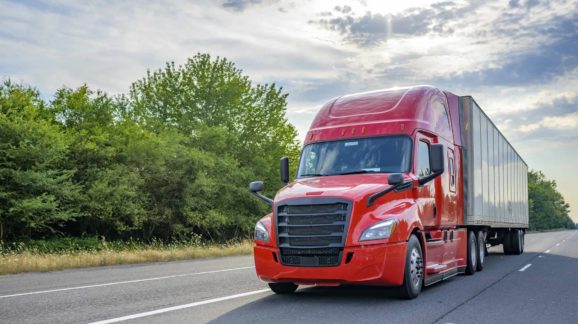America Needs More Truckers on the Road

Photo Credit: Getty
Severe backups and bottlenecks in the nation’s ports, particularly on the West Coast, have created severe logistical and supply problems throughout the country. This is threatening to cause shortages leading to empty store shelves, which will inevitably mean that consumers will get hit with increases in prices. Experts advise people to get their Christmas shopping done early if they want to get it done at all.
Several factors are causing this backup, but the most severe seems to be the slow pace with which U.S. ports operate compared to international practices. This is due at least in part to union-backed federal regulations that control shipping and transportation.
Federal safety regulations limit most commercial truck drivers to 11 hours of driving time in a 14-hour workday, reports The Wall Street Journal, presumably for safety reasons. And unions fight efforts to make the hours more flexible. All of those country-western songs about truck drivers traveling non-stop are relics from a past era, apparently.
As a consequence, U.S. ports are only open to part of the day despite shipping being a round-the-clock affair. This policy was problematic enough prior to the COVID-19 outbreak. It is causing major issues now.
The ports of Los Angeles and Long Beach, two of the largest on the west coast, have said they would “try” operating around the clock… but only from Monday to Thursday. “It has been nearly impossible to get everyone on the same page toward 24/7 operations,” Gene Seroka, executive director of the Port of Los Angeles, told The Wall Street Journal. The Port of Los Angeles alone handles 17 percent of all U.S. imports.
“It’s impossible to effectively move such volumes if we don’t move to 24/7 operations across the supply chain,” concurred Mario Cordero, executive director at the Port of Long Beach. “They do it in other parts of the world.”
Who is “everyone” in this context? Well, in addition to the ports themselves, shipping companies, the trucking industry, and the unions that represent the workers in all three of those, the ports are overseen by the following federal entities:
- The Coast Guard;
- Department of Homeland Security;
- Department of Transportation;
- U.S. Navy;
- National Oceanic and Atmospheric Administration;
- Environmental Protection Agency; U.S. Customs and Border Protection;
- Maritime Administration; and
- Army Corps of Engineers.
Surprisingly, the Department of Commerce isn’t involved, but we probably shouldn’t give the government any ideas.
It is hardly surprising that, with that many groups with oversight, getting everyone to agree to a reasonable modification of the rules isn’t easy. The limited window of time to operate on docks causes delays with trucks that haul the cargo and in out. Truckers, not unsurprisingly, prefer to start early in the day in hopes of finishing by a reasonable time when they reach their limit for hours. So there is a surplus of drivers early in the day and a decline in the afternoons and evenings. Empty containers often aren’t removed quickly, taking up space needed for new containers coming in. The Port of Los Angeles saw imports rise by 27 percent this summer compared to last year, while exports fell by 12 percent over the same period. That has resulted in a 47 percent increase in the number of empty containers clogging the port, reported Forbes.
“There is too much congestion from empty containers on terminals,” Matt Schrap, chief executive of the Harbor Trucking Association, which represents carriers at the ports of Los Angeles and Long Beach, told the Journal. “[That] is preventing us from returning empties that we are storing in our yards.”
Meanwhile there’s a shortage of containers to use for shipping across oceans. Forbes reports that the average price for one is now about $6,000, a 100 percent increase in just five years. Shipping vessels and their container cargo are sitting 2.5 times longer at anchor than they used to before COVID, despite productivity being up 50 percent at the terminals.
Of course, if they could just move the empty containers to the ships at sea they could alleviate one of the main causes of the backup. But as with so many things in life, while there may be a simple solution, there isn’t necessarily an easy one. Hiring more truck drivers is the obvious solution but Forbes reports that recruiting firms are finding only one driver for every nine open jobs. Those are with the larger companies. The overwhelming majority of companies in the industry have five trucks or even less. However, the cost of buying a freight-shipping truck has risen by 50 percent in last year, resulting in fewer independent drivers getting into the business. Why are the prices rising? Well, delays on shipping have resulted in shortages of materials for manufacturers, so…